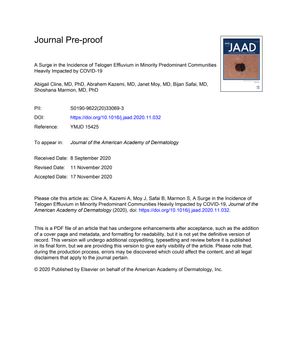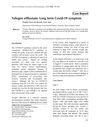A Surge in the Incidence of Telogen Effluvium in Minority Predominant Communities Heavily Impacted by COVID-19
December 2020
in “
Journal of The American Academy of Dermatology
”

TLDR More people, especially Hispanic/Latinx, in certain NYC communities experienced temporary hair loss during the COVID-19 pandemic.
The document reports a significant increase in the incidence of telogen effluvium (TE), a form of temporary hair loss, in minority predominant communities in New York City (NYC) during the COVID-19 pandemic. A retrospective analysis was conducted at two safety-net hospitals in Brooklyn and Manhattan, which serve racially diverse neighborhoods. The study found that from November 1, 2019, to February 29, 2020, there was an average of 7.5 cases of TE every two months, with an incidence of 0.4%. This rate remained stable through June 2020. However, in July and August 2020, there were 43 patients with TE, corresponding to an incidence of 2.3%, which is more than a 400% increase. The majority of the increase was among persons of color, particularly Hispanic/Latinx individuals, which aligns with the high COVID-19 mortality rates in these populations. Interestingly, no substantial increase in TE was noted in Black/African American individuals, and prior to the pandemic, no cases of TE were recorded in men, but during the pandemic, five cases were identified. The study suggests that the surge in TE cases could be related to stress from the pandemic or the physiological effects of COVID-19 infection, although only two patients were tested for COVID-19, both with negative results. The study acknowledges limitations such as potential coding errors and bias due to public knowledge of hair loss associated with COVID-19. Dermatologists are advised to be prepared for an influx of TE cases in communities significantly impacted by COVID-19.



